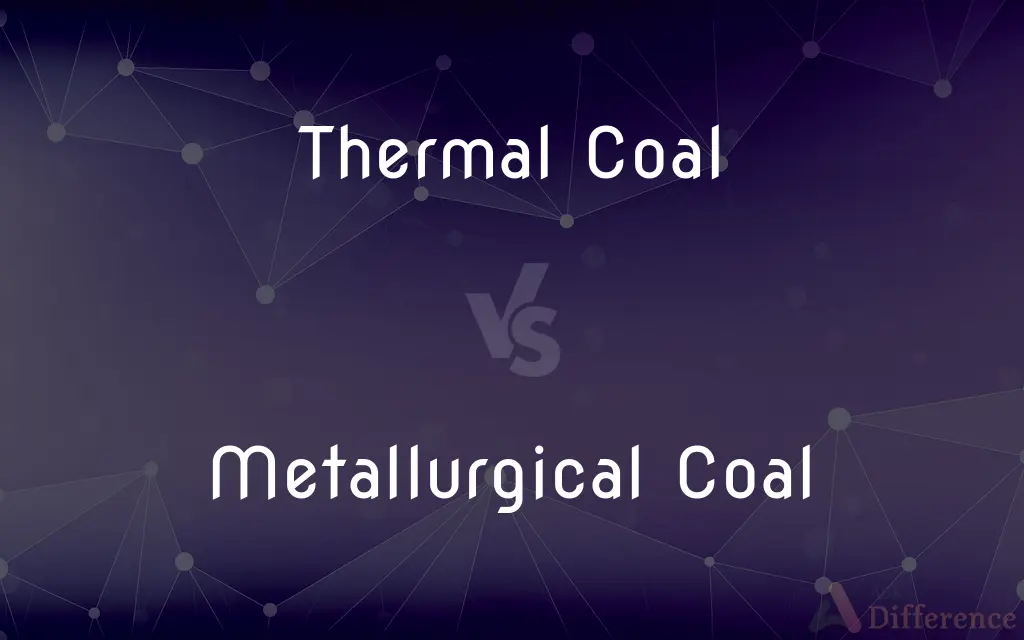Thermal Coal vs. Metallurgical Coal — What's the Difference?
Edited by Tayyaba Rehman — By Maham Liaqat — Updated on April 22, 2024
Thermal coal is primarily used for power generation due to its high heat output, while metallurgical coal, or coking coal, is essential in steel production for its carbon content and coking properties.

Difference Between Thermal Coal and Metallurgical Coal
Table of Contents
ADVERTISEMENT
Key Differences
Thermal coal, also known as steam coal, is characterized by its ability to generate heat upon combustion, making it ideal for electricity generation in power plants. Its main attribute is its high calorific value, which determines the amount of energy produced. On the other hand, metallurgical coal, or coking coal, has distinct properties that allow it to be converted into coke, a necessary component in the steel-making process.
The extraction and processing of thermal coal focus on maximizing energy output and efficiency, with less emphasis on specific chemical properties beyond its calorific value. In contrast, metallurgical coal undergoes a more selective mining and processing approach to ensure that the coal meets precise coking characteristics, including fluidity, volatility, and ash content. These properties are critical for the coke's ability to support the blast furnace's weight and maintain the necessary temperature for steel production.
Thermal coal's market demand is primarily driven by the energy sector, with its price and consumption closely tied to the global demand for electricity. Environmental concerns and the shift towards renewable energy sources have impacted its use and market dynamics. Conversely, metallurgical coal's demand is closely linked to the steel industry, which remains robust due to steel's role in infrastructure, construction, and manufacturing. The cyclical nature of the steel industry significantly influences metallurgical coal's market.
Pollution and environmental impact are major concerns for both types of coal. However, the use of thermal coal in power generation contributes more significantly to CO2 emissions and air pollution, leading to stricter regulations and a gradual shift to cleaner energy sources. Metallurgical coal, while also a source of emissions, is considered irreplaceable in the current steel production process, with ongoing research focusing on cleaner alternatives or more efficient production methods to reduce its environmental footprint.
The primary distinction between thermal coal and metallurgical coal lies in their end-use applications and the specific properties required for those applications. Thermal coal's role in power generation contrasts with metallurgical coal's critical function in steel production, reflecting their different impacts on the economy and the environment.
ADVERTISEMENT
Comparison Chart
Primary Use
Electricity generation
Steel production
Key Properties
High calorific value
Coking properties, carbon content
Processing
Focused on energy output
Selective, for coking quality
Market Demand
Driven by energy sector
Linked to steel industry
Environmental Impact
High CO2 emissions
Emissions during coking process
Price Sensitivity
To global electricity demand
To steel industry cycles
Pollution Concerns
Significant in combustion
Mainly in production process
Substitutability
Increasingly substituted by renewables
Few viable alternatives in steel production
Regulation
Stringent emissions standards
Focus on cleaner production methods
Compare with Definitions
Thermal Coal
Increasingly replaced by alternative energy sources.
Solar and wind energy are reducing reliance on thermal coal.
Metallurgical Coal
Requires specific coking properties.
The quality of coke depends on the coking coal's fluidity and volatility.
Thermal Coal
Subject to environmental regulations.
Power plants use thermal coal under strict emissions controls.
Metallurgical Coal
Essential for steel production.
Metallurgical coal is converted into coke for use in blast furnaces.
Thermal Coal
Demand driven by global electricity needs.
Rising electricity consumption increases thermal coal demand.
Metallurgical Coal
Few substitutes in current steel-making processes.
Research focuses on cleaner alternatives to metallurgical coal.
Thermal Coal
Used for heating and power generation.
Thermal coal is burned in power plants to generate electricity.
Metallurgical Coal
More selective mining and processing.
Only coal with specific characteristics is used as metallurgical coal.
Thermal Coal
Characterized by its high heat output.
High-calorific thermal coal is preferred for efficient energy production.
Metallurgical Coal
Demand correlates with steel industry cycles.
An infrastructure boom increases demand for metallurgical coal.
Common Curiosities
How do thermal and metallurgical coal differ in use?
Thermal coal is for power generation, while metallurgical coal is for steel manufacturing.
What is metallurgical coal?
Metallurgical coal, or coking coal, is used to produce coke, vital for steel production.
Why is metallurgical coal important in steel production?
It's converted into coke, which provides the necessary heat and chemical reduction in blast furnaces.
What are the environmental impacts of using thermal coal?
It contributes significantly to CO2 emissions and air pollution from power generation.
What is thermal coal?
Thermal coal is used primarily for generating electricity due to its high heat output.
What determines the quality of metallurgical coal?
Its coking properties and carbon content, crucial for the steel-making process.
How does the demand for thermal coal change?
It fluctuates with global electricity demand but is decreasing due to renewable energy sources.
Can thermal coal be used as metallurgical coal?
No, because it lacks the specific properties required for coking in steel production.
What role does thermal coal play in renewable energy transition?
As a bridge energy source, although it's being phased out in favor of more sustainable options.
Can the steel industry operate without metallurgical coal?
Currently, it's challenging due to the essential role of coke in steel production processes.
Is there a substitute for metallurgical coal in steel production?
Currently, there are few viable alternatives, but research is ongoing for cleaner processes.
How is the mining of thermal coal different from metallurgical coal?
Thermal coal mining focuses on quantity and calorific value, while metallurgical coal mining prioritizes specific coking qualities.
Will the demand for metallurgical coal decrease in the future?
It may fluctuate with steel industry needs, but research into alternatives could impact long-term demand.
What are the challenges in replacing metallurgical coal?
Finding materials that can replicate coke's role in steel production while minimizing environmental impact.
What is being done to reduce the environmental impact of metallurgical coal?
Efforts include improving the efficiency of steel production and researching alternative methods.
Share Your Discovery

Previous Comparison
Offset Printing vs. Digital Printing
Next Comparison
Red Muscle vs. White MuscleAuthor Spotlight
Written by
Maham LiaqatEdited by
Tayyaba RehmanTayyaba Rehman is a distinguished writer, currently serving as a primary contributor to askdifference.com. As a researcher in semantics and etymology, Tayyaba's passion for the complexity of languages and their distinctions has found a perfect home on the platform. Tayyaba delves into the intricacies of language, distinguishing between commonly confused words and phrases, thereby providing clarity for readers worldwide.
















































